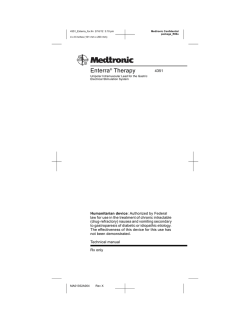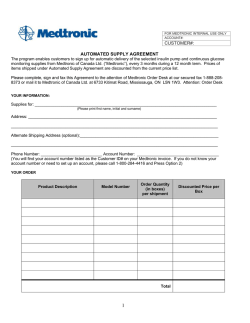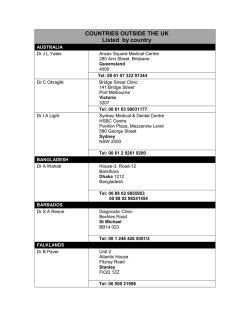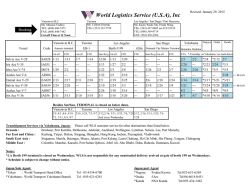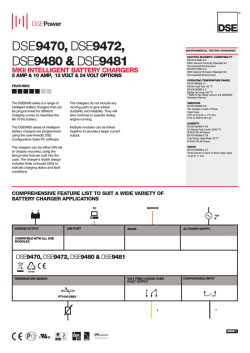
Activa® RC and Activa PC
M927893A_fc.fm 8/21/08 3:23 pm Activa® RC and Activa PC Multi-program neurostimulators Information for prescribers c Rx only 0123 M927893A002 M927893A_fc.fm 8/21/08 3:23 pm Medtronic®, Activa®, Itrel®, and Soletra® are registered trademarks of Medtronic, Inc. M927893A002 M927893ATOC.fm 8/21/08 3:23 pm Table of contents Contraindications 3 Warnings 3 Precautions 5 Physician training 5 Storage and sterilization 6 System implant 6 Clinician programming 8 Patient programming and patient control devices 9 Charging system 9 Patient activities 10 Component disposal 10 Patient selection (Activa RC only) 11 Clinical studies and adverse events 12 Adverse events summary 12 Patient counseling information 13 Appendix A: Electromagnetic interference 15 Hospital or medical environment 15 Home or occupational environment 16 Refer to the indications sheet for indications and related information. Refer to the device implant manual for device description, package contents, device specifications, and instructions for use. Refer to System Eligibility, Battery Longevity, Specifications reference manual packaged with the software application card for neurostimulator selection, battery longevity calculations and specific neurostimulator specifications. c Refer to the clinical summary booklet packaged with the neurostimulator for information on the clinical study results of the neurostimulation system and individualization of treatment. Information for prescribers M927893A002 2007-09 English 1 M927893ATOC.fm 2 English M927893A002 8/21/08 3:23 pm Information for prescribers 2007-09 M927893A_ch.fm 8/21/08 3:23 pm Contraindications Implantation of an Activa RC or Activa PC Brain Stimulation System is contraindicated for: ■ Patients exposed to diathermy. Do not use shortwave diathermy, microwave diathermy or therapeutic ultrasound diathermy (all now referred to as diathermy) on patients implanted with a neurostimulation system. Energy from diathermy can be transferred through the implanted system and can cause tissue damage at the location of the implanted electrodes, resulting in severe injury or death. Diathermy can also damage the neurostimulation system components, resulting in loss of therapy and requiring additional surgery for system explantation and replacement. Advise your patient to inform all their health care professionals that they should not be exposed to diathermy treatment. Injury to the patient or damage to the device can occur during diathermy treatment when: – the neurostimulation system is turned ON or OFF. – diathermy is used anywhere on the body - not just at the location of the neurostimulation system. – diathermy delivers heat or no heat. – any component of the neurostimulation system (lead, extension, neurostimulator) remains in the body. ■ Patients who will be exposed to Magnetic Resonance Imaging (MRI) using a full body transmit radio-frequency (RF) coil, a receive-only head coil, or a head transmit coil that extends over the chest area. Performing MRI with this equipment can cause tissue lesions from component heating, especially at the lead electrodes, resulting in serious and permanent injury including coma, paralysis or death. Refer to the MRI guidelines manual packaged with this product for comprehensive safety information and instructions. ■ Patients for whom test stimulation is unsuccessful. ■ Patients who are unable to properly operate the Activa PC Brain Stimulation System, which includes a patient programmer, or the Activa RC Brain Stimulation System, which includes a patient programmer and a charging system. Warnings Avoid excessive stimulation – There is a potential risk of brain tissue damage for stimulation parameter settings of high amplitudes and wide pulse widths. The Activa System is capable of parameter settings outside the range of those used in the clinical studies. Stimulation parameter ranges for symptom suppression are typically within 1 to 3.5 V for amplitude, 60 to 120 µsec for pulse width, and 130 to 185 Hz for rate. Higher amplitude and pulse width may indicate a system problem or less than optimal lead placement. Parameter values exceeding the recommended output settings should only be programmed with due consideration of the warnings concerning charge densities described in the programming guide. Information for prescribers M927893A002 2007-09 English 3 M927893A_ch.fm 8/21/08 3:23 pm If programming of stimulation parameters exceeds charge density limits, the following programmer warning appears: WARNING: CHARGE DENSITY MAY BE HIGH ENOUGH TO CAUSE TISSUE DAMAGE. The use of rates less than 30 Hz may “drive” tremor, ie, cause it to occur at the same frequency as the programmed frequency. For this reason, rates should not be programmed below 30 Hz. Case damage – If the neurostimulator case is ruptured or pierced due to outside forces, severe burns could result from exposure to the battery chemicals. Coagulopathies – Use extreme care with lead implantation in patients with a heightened risk of intracranial hemorrhage. Physicians should consider underlying factors, such as previous neurological injury, or prescribed medications (anticoagulants), that may predispose a patient to the risk of bleeding. Electromagnetic interference (EMI) – Electromagnetic interference is a field of energy generated by equipment found in the home, work, medical or public environments that is strong enough to interfere with neurostimulator function. Neurostimulators include features that provide protection from electromagnetic interference. Most electrical devices and magnets encountered in a normal day are unlikely to affect the operation of a neurostimulator. However, sources of strong electromagnetic interference can result in the following effects: ■ Serious patient injury or death - it is possible for the extension, lead, or both to “pick up” electromagnetic interference and deliver an excess voltage, which can in turn deliver an excessive amount of heat to the brain. ■ System damage - resulting in a loss of or change in symptom control and requiring surgical replacement. ■ Operational changes to the neurostimulator - causing it to turn on or off, or to reset to power-on-reset (POR) settings, resulting in loss of stimulation, return of symptoms, and in the case of POR, requiring reprogramming by a clinician. ■ Unexpected changes in stimulation - causing a momentary increase in stimulation or intermittent stimulation, which some patients have described as a jolting or shocking sensation. Refer to “Appendix A: Electromagnetic interference” on page 15 for guidelines on the interaction of electromagnetic interference and an implanted Activa RC or Activa PC System. Importance of regular recharging (Activa RC only) – Inform patients and their caregivers of the importance of maintaining a regular schedule of recharging. Magnetic Resonance Imaging – Do not conduct an MRI examination on a patient with any implanted Activa System component until you read and fully understand all MRI information in this manual and the safety information and instructions in the MRI guidelines manual packaged with this product. Do not conduct an MRI examination at parameters other than those described in these guidelines. Failure to follow all warnings and guidelines related to MRI can result in serious and permanent injury including coma, paralysis, or death. Placement of lead-extension connector in neck – Do not place the lead-extension connector in the soft tissues of the neck. Placement in this location has been associated with an increased incidence of lead fracture. 4 English M927893A002 Information for prescribers 2007-09 M927893A_ch.fm 8/21/08 3:23 pm Replacement Procedure – Do not replace two Soletra Model 7426 Neurostimulators with one bilateral neurostimulator unless retunneling is performed so both lead-extensions are on the same side of the body. Otherwise, the “looped” configuration formed by the leadextensions increases the potential for electromagnetic interference (EMI) effects. Return of symptoms and rebound effect – Inform patients and their caregivers that abrupt cessation of stimulation for any reason, including failure to maintain adequate battery charge in rechargeable neurostimulators, will probably cause a return of disease symptoms. In some cases, symptoms may return with intensity greater than was experienced prior to system implant (rebound effect). This can in rare cases constitute a medical emergency. For patients with rechargeable neurostimulators, it is important that the clinician emphasize the following: ■ Patients must willing and able to perform battery status checks and battery recharge activities on a frequent basis. ■ The device charge level should be maintained such that symptoms are controlled. ■ The recharge warnings from the patient programmer must be understood and heeded by the patient and caregiver. ■ Medication may aid in symptom control during short periods of time following depletion of the device before a recharge session. If symptoms worsen or do not abate following recharge, the patient should contact his or her clinician immediately so the status of the system can be assessed and the condition of the patient can be monitored. Theft Detectors and Screening Devices – Theft detectors found in retail stores, public libraries, etc., and airport/security screening devices may cause the stimulation power source of an implantable neurostimulation system to switch Off It is also possible that sensitive patients, or those with low stimulation thresholds, may experience a momentary increase in their perceived stimulation. For other indications, higher levels of stimulation have been described as uncomfortable (“jolting” or “shocking”) by some patients as they pass through these devices. Refer to “Appendix A: Electromagnetic interference” for more information. Precautions Physician training Prescribing physicians should be experienced in the diagnosis and treatment of movement disorders and should be familiar with the use of the Activa System. Implanting physicians should have expertise with functional stereotactic neurosurgical treatment of movement disorders. Such expertise should include knowledge of the anatomical and neurophysiological characteristics of the targeted nucleus, surgical and /or implantation techniques for the Activa System, operational and functional characteristics of the Activa System, and experience in the continued management of patients by stimulation parameter adjustment. Physicians may contact Medtronic before prescribing or implanting an Activa System for the first time and request a referral to a physician experienced in the use of Activa Therapy. Prescribing and implanting physicians of Activa RC systems should be aware of the patient requirements for a rechargeable neurostimulation system. Information for prescribers M927893A002 2007-09 English 5 M927893A_ch.fm 8/21/08 3:23 pm All Activa System programming should be by or under the supervision of a physician or other experienced medical personnel familiar with the use of the programming software and equipment. Physicians should be thoroughly familiar with Activa System supporting material, including all product labeling and education and training materials. Storage and sterilization Component packaging – Do not implant a component if the following circumstances have occurred: ■ The storage package has been pierced or altered because component sterility cannot be guaranteed and infection may occur. ■ The component shows signs of damage because the component may not function properly. ■ The use-by date has expired because component sterility cannot be guaranteed and infection may occur; also, neurostimulator battery longevity may be reduced and may require early replacement. Sterilization – Medtronic has sterilized the package contents according to the process indicated on the package label before shipment. This device is for single use only and is not intended to be resterilized. Storage temperature: leads and extensions – Do not store or transport the leads or extensions above 57°C (135°F) or below -34°C (-30°F). Temperatures outside this range can damage components. Storage temperature: neurostimulators – Do not store or transport the neurostimulator above 52°C (125°F) or below -18°C (0°F). Temperatures outside this range can damage components. System implant Battery longevity and brain target selection – Stimulation settings for systems implanted in the internal Globus Pallidus (GPi) may be higher than stimulation settings for systems implanted in the Subthalmic Nucleus (STN). Consequently, when implanted in the Gpi, rechargeable systems may need to be charged more frequently and nonrechargeable systems may have reduced battery longevity compared to systems implanted in the STN. Compatibility, all components – Follow these guidelines when selecting system components: ■ Medtronic components: For proper therapy, use only Medtronic Neurological components that are compatible or specified in an intended use statement (if present). Components are compatible when the following conditions are met: – Components have the same indication. – For implanted components, the contact spacing and the number of electrode contacts at the connections for the lead and extension/neurostimulator or extension and neurostimulator are the same. For each product, refer to the indication insert(s) and shipping label artwork for this information. 6 English M927893A002 Information for prescribers 2007-09 M927893A_ch.fm 8/21/08 3:23 pm Non-Medtronic components: No claims of safety or efficacy are made with regard to the compatibility of using non-Medtronic components with Medtronic components. Refer to the non-Medtronic documentation for information. Components – The use of non-Medtronic components with this system may result in damage to Medtronic components, loss of stimulation or patient injury. Component failures – The Activa System may unexpectedly cease to function due to certain events. These events, which can include electrical short or open circuits, conductor (wire) fracture, and insulation breaches, cannot be predicted. The patient's disease symptoms will return if the device ceases to function. Component handling – Handle the implantable components of this system with extreme care. These components may be damaged by excessive traction or sharp instruments, which may result in intermittent or loss of stimulation, requiring surgical replacement. Refer to the appropriate implant manual for additional instructions. Extension routing for multiple leads – When multiple leads are implanted, route the lead-extensions so the area between them is minimized (Figure 1). If the lead-extensions are routed in a loop, the loop will increase the potential for electromagnetic interference (EMI). ■ 3URSHU ,PSURSHU Figure 1. Routing for multiple lead-extensions. Lead materials – The polyurethane tubing of the lead may release neurotoxic or carcinogenic compounds. Data are insufficient to assess the likelihood of these effects occurring in patients who receive the device. Long-term safety and effectiveness of Activa Therapy – The long-term safety and effectiveness of Activa Therapy has not been established. Multiple implants – The long-term safety associated with leads left in place without use, replacement of leads, multiple implants into the target structure, and lead explant is unknown. Information for prescribers M927893A002 2007-09 English 7 M927893A_ch.fm 8/21/08 3:23 pm Neurostimulator location – Select a location that is: ■ a minimum of 20 cm (8 in) away from another neurostimulator to minimize telemetry interference and possible inappropriate therapy. ■ on the opposite side of the body from another active implanted device (eg, pacemaker, defibrillator) to minimize possible interaction between the devices. ■ away from bony structures (eg, 3 – 4 cm [1.2 – 1.6 in]) to minimize discomfort at the neurostimulator site. ■ away from areas of restriction or pressure to minimize the potential for skin erosion and patient discomfort. ■ in an area accessible to the patient for proper neurostimulator recharging (Activa RC only) and proper operation of a patient control device. Neurostimulator location and MRI – If MRI is planned, avoid, if possible, implanting the neurostimulator in the abdomen. This requires the use of a longer length lead/extension system that can increase the heating from MRI induced RF currents, especially at the lead electrodes. Refer to the MRI guidelines for comprehensive safety information and instructions. Clinician programming Effects on other medical devices – The Activa System may affect the operation of other implanted devices, such as cardiac pacemakers and implantable defibrillators. Possible effects include sensing problems and inappropriate device responses. If the patient requires concurrent implantable pacemaker and/or defibrillator therapy, careful programming of each system may be necessary to optimize the patient's benefit from each device. Parameter adjustment – To prevent possible unpleasant stimulation decrease the amplitude(s) to 0.0 V before: ■ connecting or disconnecting the cable to the screener or external neurostimulator. ■ replacing the external neurostimulator or screener batteries. Programmer interaction with a cochlear implant – When the patient has a cochlear implant, minimize or eliminate the potential for unintended audible clicks during telemetry by keeping the external portion of the cochlear system as far from the programming head as possible or by turning OFF the cochlear implant during programming. Programmer interaction with flammable atmospheres – The programmer is not certified for use in the presence of a flammable anaesthetic mixture with air or with oxygen or nitrous oxide. The consequences of using the programmer near flammable atmospheres are unknown. Programmer interaction with other active implanted devices – When a patient has a neurostimulator and another active implanted device (eg, pacemaker, defibrillator, neurostimulator), the radio-frequency (RF) signal used to program these devices may reset or reprogram the other device. To verify that inadvertent programming did not occur, clinicians familiar with each device should check the programmed parameters of each device before the patient is discharged from the hospital and after each programming session of either device (or as soon as possible after these times). Also, inform patients to contact their physician immediately if they experience symptoms that could be related to either device or to the medical condition treated by either device. 8 English M927893A002 Information for prescribers 2007-09 M927893A_ch.fm 8/21/08 3:23 pm Screening with external neurostimulators – When screening a patient who has multiple leads implanted, do not operate multiple external neurostimulators simultaneously. The signals from simultaneously operated external neurostimulators can interfere with each other and result in incorrect results. Telemetry signal disruption from EMI – Do not attempt telemetry near equipment that may generate electromagnetic interference (EMI). If EMI disrupts programming, move the programmer away from the likely source of EMI. Examples of sources of EMI are magnetic resonance imaging (MRI), lithotripsy, computer monitors, cellular telephones, motorized wheelchairs, x-ray equipment, and other monitoring equipment. Interrupting telemetry can result in incorrect or incomplete programming. Test stimulation – An intraoperative test stimulation phase during the lead implant procedure verifies a correct lead placement that results in symptom suppression with minimal side effects. Perform test stimulation intraoperatively. If there is no symptom suppression, do not implant the Activa System. Patient programming and patient control devices Group selection – Patients should select the group recommended by the clinician for the desired therapeutic effect. Use of another group may result in unpleasant stimulation when stimulation is turned ON. Patient control devices may affect other implanted devices – Do not place the patient control device (ie, patient programmer) over another active implanted medical device (eg, pacemaker, defibrillator, another neurostimulator). The patient control device could unintentionally change the operation of the other device. Patient device handling – To avoid damaging the device, do not immerse it in liquid; do not clean it with bleach, nail polish remover, mineral oil, or similar substances; and do not drop it or mishandle it in a way that may damage it. Patient device use – When operating a patient programmer or charging system, use special care near flammable or explosive atmospheres. An interaction between the flammable or explosive atmospheres and the battery in the device could occur. The consequences of using a battery-powered device near flammable or explosive atmospheres are unknown. Charging system Low battery charge level (Activa RC only) – Advise patients to charge the neurostimulator on a regular basis, taking into consideration the therapeutic parameters and battery usage of the patient, to prevent the battery from overdischarging. If the neurostimulator battery is allowed to overdischarge, the patient cannot charge the neurostimulator; however, the clinician may be able to restore the battery function using the Physician Recharge Mode on the recharger (refer to the troubleshooting section of the software manual). Allowing the neurostimulator battery to overdischarge will permanently affect the neurostimulator in one of the following ways: ■ Battery function is restored; however, charging sessions may be more frequent because battery capacity has been reduced. Information for prescribers M927893A002 2007-09 English 9 M927893A_ch.fm 8/21/08 3:23 pm Battery function is not restored and the neurostimulator must be surgically replaced. Battery function is not restored when: – the neurostimulator battery is permanently damaged. – the neurostimulator battery has been overdischarged and restored twice before. The third time the battery is overdischarged, the neurostimulator will reach end of service. Surgery is required to replace the neurostimulator. Wound contact (Activa RC only) – DO NOT use the recharger on an unhealed wound. The recharger, recharger antenna, and holster are not sterile, and contact with the wound may cause an infection. ■ Patient activities Component manipulation by patient – Advise your patient to avoid manipulating the implanted system components (eg, the neurostimulator, the burr hole site). This can result in component damage. Patient activities/environmental precautions – Patients should exercise reasonable caution in avoidance of devices which generate a strong electric or magnetic field. Close proximity to high levels of electromagnetic interference (EMI) may cause a neurostimulator to switch On or Off. The system also may unexpectedly cease to function. For these reasons, the patient should be advised about any activities that would be potentially unsafe if their symptoms unexpectedly return. For additional information about devices which generate electromagnetic interference, call Medtronic at 1-800-707-0933. Component disposal When explanting a device (eg, replacement, cessation of therapy, or postmortem), or when disposing of accessories, follow these guidelines: ■ If possible, return the explanted device with completed paperwork to Medtronic for analysis and disposal. Refer to the back cover for the mailing addresses. ■ To allow for device analysis, do not autoclave the device or expose the device to ultrasonic cleaners. ■ Dispose of any unreturned components according to local environmental regulations; in some countries, explanting a battery-powered implantable device is mandatory. – Do not incinerate or cremate the neurostimulator because it may explode if subjected to these temperatures. – Do not reuse any implantable device or implantable accessory after exposure to body tissues or fluids because the functionality of the component cannot be guaranteed. 10 English M927893A002 Information for prescribers 2007-09 M927893A_ch.fm 8/21/08 3:23 pm Patient selection (Activa RC only) Consultation with the neurologist who will provide follow-up care is recommended prior to patient selection. Compliance with checking the battery status regularly is critical. Medtronic recommends a practice period for the patient and associated caregiver prior to implant, to assess whether the patient will be willing and able to incorporate the required recharging activities into current activities of daily living. Selection of patients living in assisted care or nursing home facilities is not recommended, as maintenance of therapy maybe relegated to the care staff who may not be adequately trained to assist with recharge activities. Careful consideration should be exercised when determining if a patient is appropriate for a rechargeable Activa RC Neurostimulator. The following should be considered for the expected duration of the implant period: ■ Patient’s ability to use the patient programmer and correctly interpret the icons that appear on the screen ■ Patient's ability to regularly monitor the status of the rechargeable battery and respond appropriately ■ Patient’s ability to accurately locate their implanted neurostimulator, properly position the recharge antenna for sufficient coupling, put on the recharge holster/belt, and monitor progress during the recharge session ■ Patient's ability to perform charging activities for sufficient duration and frequency to maintain therapy and to perform charging activities on an ongoing basis Special consideration should be given to: ■ Available level of support from a care giver, to assist the patient with monitoring and recharging activities ■ Expected effect from cessation of therapy, should patient fail to recharge on schedule or when alerted ■ Patient's age, as very young or very old patients may have difficulty performing required monitoring and recharging of the device ■ Patient's mental capacity, as patients with cognitive impairment or those prone to developing dementia would likely have difficulty performing device-related tasks without assistance ■ Patient’s physical ability, as patients with higher degrees of motor impairment might have difficulty with the physical requirements of monitoring and recharging the device ■ Patient’s visual ability, the patient needs to be able to read the patient programmer or recharger display screen to assess battery status ■ Patient’s willingness to use the patient programmer alert or a different method that will be effective in reminding the patient to check the battery status on a regular basis ■ Patient’s (and caregiver’s) willingness to continue recharging activities as necessary under all circumstances, eg, power outages, travel, and hospitalizations, and recognize the critical nature of maintaining a charged battery in the neurostimulator Information for prescribers M927893A002 2007-09 English 11 M927893A_ch.fm 8/21/08 3:23 pm Clinical studies and adverse events The clinical use of implantable deep brain stimulation systems for Parkinson’s disease and essential tremor is supported by the Medtronic Parkinson’s disease clinical studies using the Itrel II Model 7424 Neurostimulator. Because safety and effectiveness of the Activa Parkinson’s Control therapy was established using bilateral Itrel II neurostimulators, clinical results and adverse event rates associated with other implantable deep brain stimulation systems for Parkinson’s disease and essential tremor may not be identical. Refer to the system components sheet packaged with the DBS Lead for more information about specific Activa System components. Adverse events summary Deep brain stimulation may potentially have the following adverse events: ■ Allergic or immune system response to the implanted materials ■ Infection ■ Lead, extension, or neurostimulator erosion through the skin or migration ■ Persistent pain at the neurostimulator site ■ Seroma or hematoma at the neurostimulator site ■ Intracranial hemorrhage, immediate or delayed, which could result in temporary or permanent muscle weakness, paralysis, aphasia, or death. ■ Lead and extension fracture ■ Loss of therapeutic effect ■ Mentation impairment such as attention or cognitive deficits, memory disturbances, confusion, or psychiatric disturbances ■ Motor problems such as paresis, weakness, incoordination, muscle spasms, gait disorders, tremor, dystonia, or chorea ■ Seizures ■ Sensory changes ■ Speech problems such as dysphasia or dysarthria ■ Undesirable sensations such as paresthesia that could be either temporary or permanent ■ Visual disturbances, such as diplopia, oculomotor difficulties or other visual field effects c For a comprehensive summary of adverse events, refer to the Clinical Summary. 12 English M927893A002 Information for prescribers 2007-09 M927893A_ch.fm 8/21/08 3:23 pm Patient counseling information Before surgery, the patient and family should be advised of the known risks of the surgical procedure and the therapy, as well as the potential benefits. After the Activa System is implanted, the patient should also be advised to read the patient manual included in the neurostimulator package. Physicians should provide patients with information about: ■ the components of the neurostimulation system: lead, extension, and neurostimulator. ■ instructions for using the neurostimulation system, including the patient programmer and charging system (Activa RC). ■ the indications, contraindications, warnings, and precautions for a neurostimulation system. Physicians should also instruct patients to: ■ always inform any healthcare personnel that they have an implanted neurostimulation system before any procedure is begun. ■ contact their physician if they notice any unusual symptoms or signs. Information for prescribers M927893A002 2007-09 English 13 M927893A_ch.fm 8/21/08 14 English M927893A002 3:23 pm Information for prescribers 2007-09 M927893A_appA.fm 8/21/08 3:23 pm Appendix A: Electromagnetic interference Electromagnetic interference is a field (electrical, magnetic or a combination of both) that is generated by various medical or environmental devices. These medical and environmental (home, occupational, and other) devices may generate enough interference to change the parameters of a neurostimulator: turn a neurostimulator off and on, or cause a neurostimulator to surge, shock, or jolt the patient. In addition, it is possible for the extension, lead, or both to “pick up” electromagnetic interference and deliver an excess voltage, which can in turn deliver an excessive amount of heat to the brain. Refer to the sections that follow for guidelines on the interaction of electromagnetic interference and an implanted Activa System. Activa neurostimulators are designed to assure immunity from most common sources of electromagnetic interference (EMI). Because many different types of EMI sources exist, it is impossible to specify all interference sources here. However, the most common sources of EMI are discussed below. Severe electromagnetic fields, such as those that exist near electrocautery equipment, can reprogram a neurostimulator, temporarily suppress the output of a neurostimulator, and cause damage to the implanted system components. Hospital or medical environment Before any medical procedure is begun, patients should always inform any health care personnel that they have an implanted neurostimulation system. The potential for the following effects results from an interaction of the neurostimulation system and equipment— even when both are working properly. Most routine diagnostic procedures, such as fluoroscopy and x-rays, are not expected to affect system operation. However, because of higher energy levels, sources such as transmitting antennas found on various diagnostic and therapeutic equipment may interfere with the Activa System. Electrocautery – Electrocautery can damage the lead, the extension, or both. It can also cause temporary suppression of neurostimulator output and/or reprogramming of the neurostimulator. If use of electrocautery is necessary, the current path (ground plate) should be kept as far away from the neurostimulator, extension, and lead as possible, and use of bipolar electrocautery is recommended. External defibrillators – If a patient requires external defibrillation, the first consideration should be patient survival. Safety for use of external defibrillatory discharges on patients with neurostimulation systems has not been established. External defibrillation may damage a neurostimulator. If external defibrillation is necessary, follow these precautions to minimize current flowing through the neurostimulator and lead system: ■ Position defibrillation paddles as far from the neurostimulator as possible. ■ Position defibrillation paddles perpendicular to the implanted neurostimulator-lead system. ■ Use the lowest clinically appropriate energy output (J [watt seconds]). ■ Confirm neurostimulation system function following any external defibrillation. Information for prescribers M927893A002 2007-09 English 15 M927893A_appA.fm 8/21/08 3:23 pm High radiation sources – High radiation sources, such as cobalt 60 or gamma radiation, should not be directed at the neurostimulator. If a patient requires radiation therapy in the vicinity of the neurostimulator, place lead shielding over the device to prevent radiation damage. Lithotripsy – Use of high output ultrasonic devices, such as an electrohydraulic lithotriptor, is not recommended for patients with an implanted neurostimulation system. While there is no danger to the patient, exposure to high output ultrasonic frequencies may result in damage to the neurostimulator circuitry. If lithotripsy must be used, do not focus the beam near the neurostimulator. Psychotherapeutic procedures – The safety of psychotherapeutic procedures using equipment that generates electromagnetic interference (eg, electroshock therapy, transcranial magnetic stimulation) has not been established. Home or occupational environment Activa neurostimulators should not be affected by normal operation of electrical equipment such as household appliances, electric machine shop tools, microwave ovens, RF transmitting systems, or microwave frequency transmitting systems. A strong magnetic field (electromagnet or permanent magnet) can switch the neurostimulator output from On to Off or Off to On, but does not change the programmed parameters. Advise your patients to avoid or to exercise care when approaching the following: ■ Theft detectors ■ Airport/security screening devices ■ Large stereo speakers with magnets ■ Electric arc welding equipment ■ Electric steel furnaces ■ Electric induction heaters (used in industry to bend plastic) ■ Power lines ■ Electric substations and power generators If your patient suspects an electrical device or magnet is interfering with the neurostimulator, advise him/her to move away from it, or turn the device off. Then, the patient can use the patient programmer to set the neurostimulator back to the desired On or Off state. When switched On, the neurostimulator will resume stimulation at the previously programmed level. Home appliances – Home appliances that are in good working order and properly grounded do not usually produce enough electromagnetic interference (EMI) to interfere with neurostimulator operation. However, items with magnets (eg, stereo speakers, refrigerators, freezers, power tools) may cause the neurostimulator to switch On or Off. Occupational environments – Commercial electrical equipment (arc welders, induction furnaces, resistance welders), communication equipment (microwave transmitters, linear power amplifiers, high-power amateur transmitters), and high voltage power lines may generate enough electromagnetic interference (EMI) to interfere with neurostimulator operation if approached too closely. 16 English M927893A002 Information for prescribers 2007-09 M927893A_appA.fm 8/21/08 3:23 pm Radio frequency sources – Analog and digital cellular phones, AM/FM radios, cordless phones, and conventional wired telephones may contain permanent magnets. To prevent undesired turning On or Off of the stimulation, these devices should be kept at least 10 cm (4 in) away from the implanted neurostimulator. Therapeutic magnets – Therapeutic magnets (for example, those found in bracelets, back braces, shoe inserts and mattress pads) can cause inadvertent on or off activations of the neurostimulator. Therefore, patients should be advised not to use them. Theft detectors and security screening devices – Patients should be advised to use care when approaching theft detectors and security screening devices (such as those found in airports, libraries, and some department stores) because these devices can turn on or turn off their neurostimulator. When approaching these devices, patients should do the following: 1. If security personnel are present, patients should show them their neurostimulator identification card and request a manual search. Security personnel may use a handheld security wand, but patients should ask the security personnel to avoid placing the wand over the neurostimulator. 2. If patients must pass through the security device, they should approach the center of the device and walk normally (Figure 2). a. If two security gates are present, they should walk through the middle, keeping as far away as possible from each gate. b. If one gate is present, they should walk as far away as possible from it. Note: Some theft detectors may not be visible. 3. Patients should proceed through the security device. Patients should not touch, lean on or linger near the security device. 'RXEOHVHFXULW\JDWH 6LQJOHVHFXULW\JDWH Figure 2. Approaching security gates. 4. If patients suspect that their neurostimulator was turned off, they should make sure someone is able to turn on the system again. (This person could be the patient, if his or her medical condition allows it. It could also be a family member or clinician who has been taught how to use the system.) Information for prescribers M927893A002 2007-09 English 17 M927893A_appA.fm 8/21/08 18 English M927893A002 3:23 pm Information for prescribers 2007-09 M927893A002_bc.fm 8/21/08 3:23 pm Contacts: Asia: Medtronic International Ltd. Tel. 02891-4068 Fax 2591-0313 Italy: Medtronic Italia SpA Tel. 02-241371 Fax 02-241381 Medtronic Asia Ltd. Tel. (02)-548-1148 Fax (02)-518-4786 Australia: Medtronic Australasia Pty. Ltd. Tel. 02-9879-5999 Fax 02-9879-5100 Austria: Medtronic Österreich GmbH Tel. 01-24044 Fax 01-24044-100 Belgium: Medtronic Belgium S.A. Tel. 02-456-0900 Fax 02-460-2667 Canada: Medtronic of Canada Ltd. Tel. (1905)-826-6020 Fax (1905)-826-6620 Czech Republic: Medtronic Czechia s.r.o. Tel. 2-965-795-80 Fax 2-965-795-89 Denmark: Medtronic-Danmark A/S Tel. 45-32-48-18-00 Fax 45-32-48-18-01 Finland: Medtronic Finland OY/LTD Tel. (09)-755-2500 Fax (09)-755-25018 France: Medtronic France S.A.S. Tel. 01-5538-1700 Fax 01-5538-1800 Germany: Medtronic GmbH Tel. 0211-52930 Fax 0211-5293100 Greece: Medtronic Hellas S.A. Tel. 02-10-677-90-99 Fax 02-10-677-93-99 Hungary: Medtronic Hungária Kft. Tel. 1-889-06-00 Fax 1-889-06-99 Ireland: Medtronic Ireland Ltd. Tel. (01)-890-6522 Fax (01)-890-7220 Tel. 06-328141 Fax 06-3215812 Japan: Medtronic Japan Tel. 3-6430-2001 Fax 3-6430-7140 Latin America: Medtronic, Inc. Tel. (1350)-500-9328 Fax (1786)-709-4244 The Netherlands: Medtronic B.V. Tel. (045)-566-8000 Fax (045)-566-8668 Norway: Medtronic Norge AS Tel. 67-10-32-00 Fax 67-10-32-10 Poland: Medtronic Poland Sp. z.o.o. Tel. (022)-465-69-00 Fax (022)-465-69-17 Portugal: Medtronic Portugal, Lda. Tel. 21-724-5100 Fax 21-724-5199 Spain: Medtronic Ibérica, S.A. Tel. 91-625-0400 Fax 91-650-7410 Sweden: Medtronic AB Tel. 08-568-585-00 Fax 08-568-585-01 Switzerland: Medtronic (Schweiz) AG Tel. 031-868-0100 Fax 031-868-0199 U.K.: Medtronic U.K. Ltd. Tel. 01923-212213 Fax 01923-241004 USA: Medtronic, Inc. Tel. (1-763)-505-5000 Toll-free: (1-800)-328-0810 Fax (1-763)-505-1000 M927893A002 M927893A002_bc.fm 8/21/08 3:23 pm Manufacturer Medtronic, Inc. 710 Medtronic Parkway Minneapolis, MN 55432-5604 USA Internet: www.medtronic.com Tel. 1-763-505-5000 Fax 1-763-505-1000 Contacts for specific countries are listed inside this cover. Medtronic E.C. Authorized Representative/Distributed by Medtronic B.V. Earl Bakkenstraat 10 6422 PJ Heerlen The Netherlands Tel. 31-45-566-8000 Fax 31-45-566-8668 Europe/Africa/Middle East Headquarters Medtronic International Trading Sàrl Route du Molliau 31 Case Postale CH-1131 Tolochenaz Switzerland Internet: www.medtronic.co.uk Tel. 41-21-802-7000 Fax 41-21-802-7900 Asia-Pacific Medtronic International Ltd. Suite 1602 16/F, Manulife Plaza The Lee Gardens, 33 Hysan Avenue Causeway Bay Hong Kong Tel. 852-2891-4068 Fax 852-2591-0313 *M927893A002* M927893A002 ©Medtronic, Inc. 2007 All Rights Reserved M927893A002
© Copyright 2025
